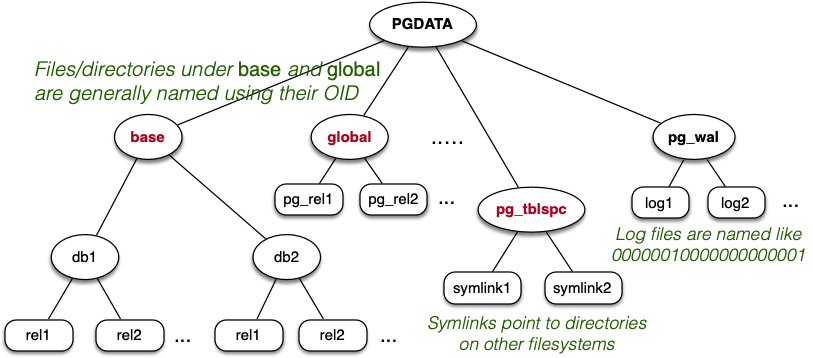PostgreSQL File Manager
File Organization

Components of Storage Subsystem
- Mapping from relations to files (
RelFileNode). - Abstraction for open relation pool (
storage/smgr). - Functions for managing files (
storage/smgr/md.c). - File-descriptor pool (
storage/file).
PostgreSQL has two basic kinds of files:
- Heap files containing data (tuples).
- Index files containing index entries.
Relations as Files
PostgresSQL identifies relation files via their OIDs. The core data structure for this is RelFileNode:
typedef struct RelFileNode {
Oid spcNode; // tablespace
Oid dbNode; // database
Oid relNode; // relation
} RelFileNode;
Global (shared) tables (e.g. pg_database) have
spcNode == GLOBALTABLESPACE_OID.dbNode == 0.
The relpath function maps RelFileNode to file:
char *relpath(RelFileNode r) // simplified
{
char *path = malloc(ENOUGH_SPACE);
if (r.spcNode == GLOBALTABLESPACE_OID) {
/* Shared system relations live in PGDATA/global */
Assert(r.dbNode == 0);
sprintf(path, "%s/global/%u", DataDir, r.relNode);
}
else if (r.spcNode == DEFAULTTABLESPACE_OID) {
/* The default tablespace is PGDATA/base */
sprintf(path, "%s/base/%u/%u", DataDir, r.dbNode, r.relNode);
}
else {
/* All other tablespaces accessed via symlinks */
sprintf(path, "%s/pg_tblspc/%u/%u/%u", DataDir, r.spcNode, r.dbNode, r.relNode);
}
return path;
}
File Descriptor Pool
Unix has limits on number of concurrently open files. PostgreSQL maintains a pool of open file descriptors:
- To hide this limitation from higher level functions.
- Low level implementation may have to start closing files after a certain point.
- When such a file is opened again, the low level implementation must reopen the file.
- This reopening of the file is not seen by the high level functions.
- It assumes the file has remained open the whole time.
- From the perspective of these high level functions, there is practically no limit to number of open files.
- To minimize expensive
open()operations.
File names are simply strings: typedef char *FileName.
Open files are referenced via: typedef int File.
A File is an index into a table of “virtual file descriptors”.
- NOT a file descriptor.
File Descriptor Pool Interface
// open a file in the database directory ($PGDATA/base/...)
File FileNameOpenFile(FileName fileName, int fileFlags, int fileMode);
// open temp file; flag: close at end of transaction?
File OpenTemporaryFile(bool interXact);
void FileClose(File file);
void FileUnlink(File file);
int FileRead(File file, char *buffer, int amount);
int FileWrite(File file, char *buffer, int amount);
int FileSync(File file);
long FileSeek(File file, long offset, int whence);
int FileTruncate(File file, long offset);
These are analogous to Unix syscalls open(), close(), read(), write(), lseek().
Virtual File Descriptors
Physically stored in dynamically-allocated array:

Also arranged into linked list by recency-of-use:

VfdCache[0] holds list head/tail pointers.
Simplified structure:
typedef struct vfd
{
s_short fd; // current FD, or VFD_CLOSED if none
u_short fdstate; // bitflags for VFD's state
File nextFree; // link to next free VFD, if in freelist
File lruMoreRecently; // doubly linked recency-of-use list
File lruLessRecently;
long seekPos; // current logical file position
char *fileName; // name of file, or NULL for unused VFD
// NB: fileName is malloc'd, and must be free'd when closing the VFD
int fileFlags; // open(2) flags for (re)opening the file
int fileMode; // mode to pass to open(2)
} Vfd;
File Manager
PostgreSQL stores each table:
- In the directory
PGDATA/pg_database.oid. - Often in multiple files (aka forks).
- Unix files can not be infinitely large.

Data files (Oid, Oid.1, …):
- Sequence of fixed-size blocks/pages (typically 8KB).
- Each page contains tuple data and admin data.
- Max size of data files 1GB (Unix limitation).

Maps
Free space map (Oid_fms):
- Indicates where free space is in data pages.
- “Free” space is only free after
VACUUM.DELETEsimply marks tuples as no longer in usexmax.
Visibility map (Oid_vm):
- Indicates pages where all tuples are “visible” (accessible to all currently active transactions).
- Such pages can be ignored by VACUUM.
Magnetic Disk Storage Manager (storage/smgr/md.c)
- Manages its own pool of open file descriptors (VFd’s).
- May use several Vfd’s to access data, if several forks.
- Manages mapping from
PageIDto file + offset.
PostgreSQL PageID values are structured:
typedef struct
{
RelFileNode rnode; // which relation/file
ForkNumber forkNum; // which fork (of reln)
BlockNumber blockNum; // which page/block
} BufferTag;
Accessing Blocks
// pageID set from pg_catalog tables
// buffer obtained from Buffer pool
getBlock(BufferTag pageID, Buffer buf)
{
Vfd vf; off_t offset;
(vf, offset) = findBlock(pageID)
lseek(vf.fd, offset, SEEK_SET)
vf.seekPos = offset;
nread = read(vf.fd, buf, BLOCKSIZE)
if (nread < BLOCKSIZE) ... we have a problem
}
findBlock(BufferTag pageID) returns (Vfd, off_t)
{
offset = pageID.blockNum * BLOCKSIZE
fileName = relpath(pageID.rnode)
if (pageID.forkNum > 0)
fileName = fileName+"."+pageID.forkNum
if (fileName is not in Vfd pool)
fd = allocate new Vfd for fileName
else
fd = use Vfd from pool
if (pageID.forkNum > 0) {
offset = offset - (pageID.forkNum*MAXFILESIZE)
}
return (fd, offset)
}